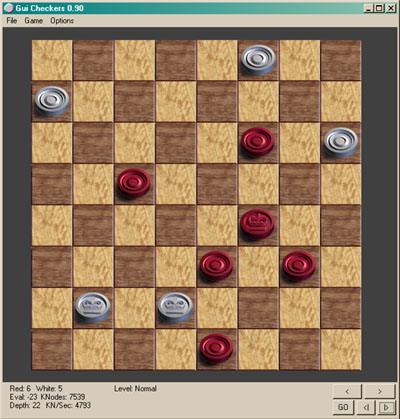
At long last, an update to Gui Checkers!
It's now called GuiNN, because it features a neural net evaluation in addition to having its own graphical user interface.
The source code has also had a major overhaul and a lot of clean-up. I had become embarassed by the old code, so now it's at least in a better state even though it's still messy in places.
After a first pass, it's very strong, and initial progress was very quick, but still far from unbeatable.
guiNN_64_avx.exe - For newer 64-bit processors that support AVX2. 30% faster.
guiNN_64_sse.exe - For older 64-bit processors.
guiNN_64_avx.dll - For use in checkerboard on processors supporting AVX2.
guiNN_64_sse.dll - For use in CheckerBoard.
Nets206.gnn - The neural net weights used to evaluate the board.
This file *must* be in the same directory as exe or dll to play properly.
database.jef - 4 piece endgame bitbases (W/L/D). This also must be in same directory as exe or dll to be used.
Source Code : Github Link
Source License : Creative Commons Attribution-NonCommercial-ShareAlike.
GuiNN is based on my previous Gui Checkers 1.10, and includes :
Art by Josh Hess
code contributions by Ed Gilbert and Ed Trice
GuiNN 2.06 vs GuiNN 2.04 .2s per-move 1173-563-6264 +27 elo (53.8%) Download Games (pdn) (7.2 MB) GuiNN 2.06 vs Cake 1.88 .2s per-move 1331-631-6038 +30 elo (54.4%) Download Games (pdn) (6.5 MB) GuiNN 2.06 vs Cake 1.89d .2s per-move 902-1132-7966 -8 elo (48.9%) Download Games (pdn) (9 MB)
GuiNN 2.04 vs Gui 1.1 .2s per-move 1169-31-1680 +145 elo Download Games (pdn) (3.5 MB) GuiNN 2.04 vs Cake 1.88 .2s per-move 339-137-3556 +17 elo Download Games (pdn) (4 MB)
whiteInputCount = 32 + 28; // 32 king squares, 28 checkers square blackInputCount = 32 + 28; network.SetInputCount(whiteInputCount + blackInputCount + 1); // +1 for side-to-move network.AddLayer(192, eActivation::RELU, eLayout::SPARSE_INPUTS); network.AddLayer(32, eActivation::RELU); network.AddLayer(32, eActivation::RELU); network.AddLayer(1); network.Build();
The learner can read in .pdn files of the games, step through each move, and for each position export the neural net inputs and target value. The target value is based on game result 1, 0.5, or 0, with 0.5 being a draw. After exporting it runs trainNet.py from the command line, which uses TensorFlow to train the weights for all the evaluation nets.
I ran training matches for 6 days on my home computer. Before having any data it of course lost every single game. The game space of standard 8x8 checkers isn't that big however, and after just half a day it was performing better than my old evaluation. On the first day I trained against my old version Gui 1.2 and Cake 1.88. The next 5 days I trained solely against Cake, and let Cake call wins/losses.
I didn't make sure the program was bug-free which led to some issues. I think early on there were some bad results calls, and sometimes it was unable to win easily won positions, and sometimes even just played randomly obviously bugged moves to throw away the game. When I noticed this I turned off own result calling and let Cake call adjucations. Later on I fixed a couple bugs causing bad moves and/or no progress but I think some issues remain. When the result changes near end of the game because of bugs it can cause bad/noisy data, so it's good to make sure the process and endgame are accurate.
I would play multiple matches in parallel using a 12 physical core Ryzen CPU. The cycle wasn't fully automated, I'd have to manually start the CheckBoard matches, so I just started them whenever I happened to be around my computer. After beating my old version, the new GuiNN was initially at -110 elo to Cake. In 3 days it went to -24 elo vs Cake. 3 more days it was at -8 elo. This includes no improvement in the last 2 matches, and I decided this was a good stopping point to release rather than getting more involved.
In Chess carefully measuring individual changes in actual matches with large numbers of games for small elo gains can eventually result in hundreds of elo overall improvement. I assume this careful method might show similar results in checkers, except : Checkers is a lot more drawish, which compresses elo, and would make slow progression slower and harder to measure. So I didn't continue refine the program beyond my quick untested updates based on what I thought would be better, and ocassional attempted bug-fixes when I saw something obviously messed up in a game.
// The neural network weights and biases for the layer. These are the values you train and save.
float weights[NUM_INPUTS][NUM_OUTPUTS];
float biases[NUM_OUTPUTS];
// Compute outputs from the inputs using the weights and biases
void LayerCompute( float inputs[NUM_INPUTS], float outputs[NUM_OUTPUTS] )
{
for ( int output = 0; output < NUM_OUTPUTS; output++ )
{
float tempValue = biases[output];
for ( int input = 0; input < NUM_INPUTS; input++ )
{
tempValue += inputs[input] * weights[input][output];
}
// (RELU activation just means clamp values below 0 to 0)
outputs[output] = tempValue < 0.0f : 0.0f : tempValue;
}
}
For multiple layers, the outputs from a layer are fed to the inputs of the next layer.
If you want a single evaluation, the last layer will have one output.
A neural net library can start to look complicated with optimizations, and support for various options that might only be sometimes used but there isn't much to a barebones implementation.
(Code for training nets however still doesn't seem that simple to me, though barebones training code can be surprisingly short too.)